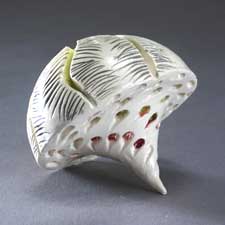Most people find it difficult to combine two of their great interests into a rewarding and exciting career.
For Adele Barres, the University not only enabled her to pursue her love of science and art, but also eventually introduced her to the world of ceramics. The first of those interests forms the basis of her work as a research secretary specializing in graphics work at the Molecular & Behavioral Neuroscience Institute (MBNI). The latter has yielded both aesthetic achievement and, sometimes, extra income.
.jpg)
In explaining her day job, Barres says, “Most of what I do right now involves adapting graphics coming from different people to work in (Microsoft) Word and PowerPoint presentations. This has included design work for presentations in class, logos, helping work on poster presentations and some illustrations for technical stories.” Her work also involves coordinating events and meetings for the directors of the institute. MBNI recently celebrated its 50th anniversary with a name change (it formerly was known as the Mental Health Research Institute (MHRI)), and Barres heavily was involved in planning the surrounding events.
Artistically, her early work garnered several awards from the Michigan Ceramic Art Association (MCAA), including a $1,000 first prize for a piece exhibited at the School of Art & Design (SoAD) Slusser Gallery, an emerging artist honor and merit awards. Barres says most of her work is conceptual, drawing from several years of studying classical Japanese dance in addition to the inspiration of the native natural surroundings of her early years.
“Japanese dance uses the fan as a prop to represent different things,” she says in explaining that her work is, for the most part, conceptual. “I try to capture movement using that, and also pattern on pattern.”
Her work has been featured in more than a dozen shows, and she’s sold hundreds of pieces, some for as much as $1,000. Her work also has been a staple of exhibits put on by the Gifts of Art program, which uses art to aid in the healing process for U-M Health System patients and their families. One piece also will be featured in an upcoming show at the A. Alfred Taubman Health Care Center.
While all that might seem like a long way from her roots, she believes the journey has been a natural one.

“When I was younger, I lived in Hawaii and enjoyed both science and art,” says Barres, adding that her early years introduced her to a lot of organic forms, plant forms and “oceanic experiences.” She was fascinated with reef denizens such as sea urchins, moray eels, jellyfish, coral and orchids.
After earning a Bachelor of Science in biology from the University of Hawaii, she became interested in biological illustration, which drew her to U-M—No. 1 of 10 schools in the nation with such a program.
After talking to the head of the bio/med illustration program, Barres decided to get an art degree before considering graduate school.
While earning a Bachelor of Fine Arts in ceramics at U-M, Barres worked part time at the then MHRI as a word processor. Barres left U-M to attend graduate school in ceramics at Eastern Michigan University. After she graduated a friend at the institute asked if she was interested in a full-time job.
Since then her work has evolved from technical word processing into a more artistic approach. While the University has offered Barres an interesting career, she credits the SoAD with helping develop her love for art.
“My time at the U-M Art School opened my eyes to new forms of artistic expression—ceramics in particular,” she says. “I happen to be one of those people who think easier in 3-D than in 2-D. Ceramics gives me the opportunity to work sculpturally and still include color and pattern in my work.”
Attributing her success as a ceramicist to her background in science, Barres continues to create sculptures in her free time.
“My favorite ceramic pieces are the ones that actually do something I never expect and act as a revelation,” says Barres. “I once had a sculpture teacher who said the best sculpture can be seen from any position and still looks interesting. I’ve almost done this once. What a shock!”
Barres has a work space at home where she initiates her conceptual pieces, as well as the more practical ones she sells through the Ann Arbor Potters Guild, in which she holds a membership. Right now she’s working on a two-level serving tray inspired by the stages and runways of the dance world.
Barres says she has been extremely active in MCAA, serving as president, vice president and secretary, helping to organize competitions. But she also says it may be time to slow down a bit.
“I’m trying to make the transition to being an at-large member.”
Her other artistic interests include watercolor, fabric painting and jewelry, among other hobbies.

